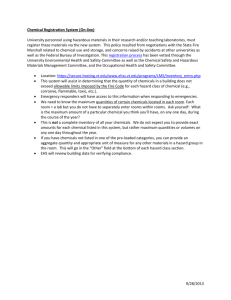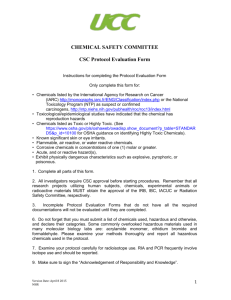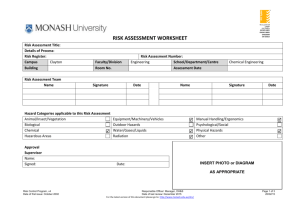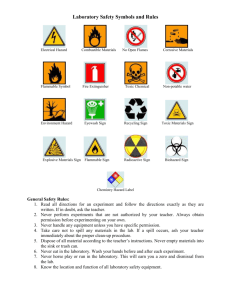Reactive Chemicals - Louisiana State University
advertisement
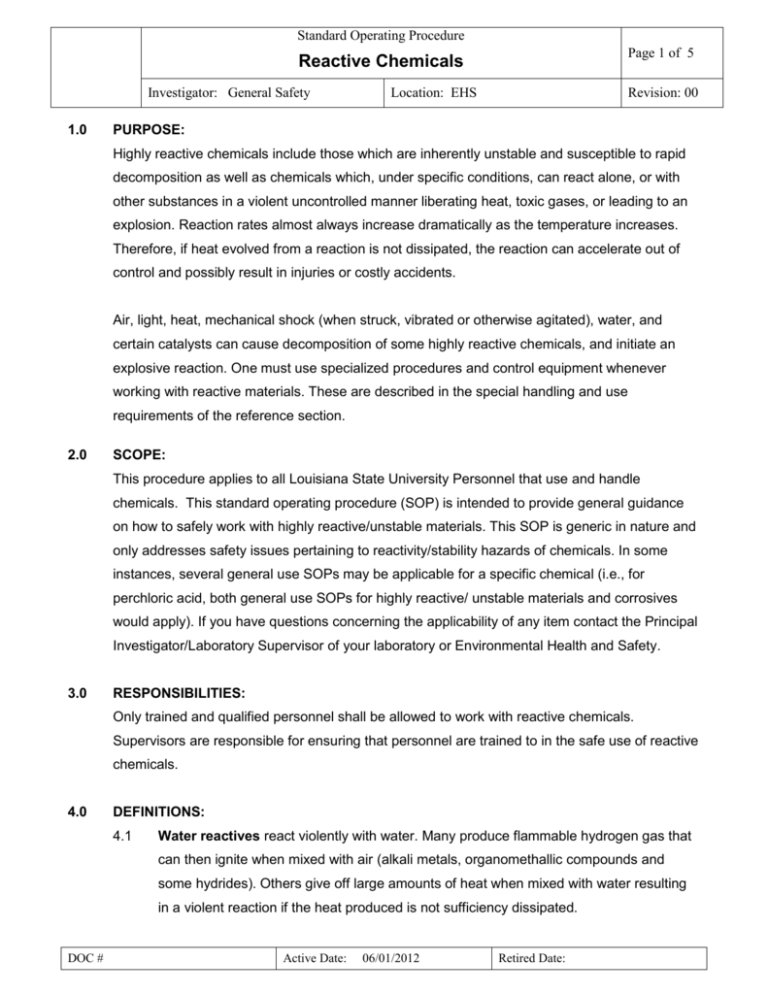
Standard Operating Procedure Page 1 of 5 Reactive Chemicals Investigator: General Safety 1.0 Location: EHS Revision: 00 PURPOSE: Highly reactive chemicals include those which are inherently unstable and susceptible to rapid decomposition as well as chemicals which, under specific conditions, can react alone, or with other substances in a violent uncontrolled manner liberating heat, toxic gases, or leading to an explosion. Reaction rates almost always increase dramatically as the temperature increases. Therefore, if heat evolved from a reaction is not dissipated, the reaction can accelerate out of control and possibly result in injuries or costly accidents. Air, light, heat, mechanical shock (when struck, vibrated or otherwise agitated), water, and certain catalysts can cause decomposition of some highly reactive chemicals, and initiate an explosive reaction. One must use specialized procedures and control equipment whenever working with reactive materials. These are described in the special handling and use requirements of the reference section. 2.0 SCOPE: This procedure applies to all Louisiana State University Personnel that use and handle chemicals. This standard operating procedure (SOP) is intended to provide general guidance on how to safely work with highly reactive/unstable materials. This SOP is generic in nature and only addresses safety issues pertaining to reactivity/stability hazards of chemicals. In some instances, several general use SOPs may be applicable for a specific chemical (i.e., for perchloric acid, both general use SOPs for highly reactive/ unstable materials and corrosives would apply). If you have questions concerning the applicability of any item contact the Principal Investigator/Laboratory Supervisor of your laboratory or Environmental Health and Safety. 3.0 RESPONSIBILITIES: Only trained and qualified personnel shall be allowed to work with reactive chemicals. Supervisors are responsible for ensuring that personnel are trained to in the safe use of reactive chemicals. 4.0 DEFINITIONS: 4.1 Water reactives react violently with water. Many produce flammable hydrogen gas that can then ignite when mixed with air (alkali metals, organomethallic compounds and some hydrides). Others give off large amounts of heat when mixed with water resulting in a violent reaction if the heat produced is not sufficiency dissipated. DOC # Active Date: 06/01/2012 Retired Date: Standard Operating Procedure Page 2 of 5 Reactive Chemicals Investigator: General Safety 4.2 Location: EHS Revision: 00 Pyrophoric materials ignite spontaneously when exposed to oxygen and/or moisture in air at or below 130oF. These must be stored under mineral oil or an inert dry atmosphere depending on the substance. Examples: phosphorus, titanium dichloride, tributylaluminum, sodium, and lithium hydride 4.3 Incompatible materials must be sufficiently segregated in storage to prevent mixing during fires, explosions, and natural disasters. Accidents with incompatible materials often occur during the commingling of wastes in laboratories. Accidental contact of incompatible chemicals can result in: Generation of heat (acids & bases) Violent reaction (acrolein & acids or other catalyst) Formation of toxic vapors or gases (cyanide salt & acid) Formation of a flammable gas (alkali metal & water) Fire or Explosion (perchloric acid & acetic anhydride) 4.4 An explosive is substance or mixture of substances that when initiated by heat, light, friction, impact, or detonation undergoes a rapid chemical reaction giving off large volumes of hot gases. The reaction usually involves a decomposition of the substance(s) but may be caused by a rapid polymerization. Fires typically accompany an explosion. Explosives may detonate (create a high-pressure wave traveling between 1000-9000 meters/second) or deflagrate (rapid decomposition of explosive but little to no highpressure wave). 4.5 Oxidizing agents in addition to their corrosive properties are powerful oxidizing agents and present fire and explosion hazards on contact with organic compounds and other oxidizable substances. 4.6 Organic peroxides are among the most hazardous substances used in the laboratory both fuels and oxidizers in one. They are typically low power explosives and very easy to initiate through sparks or shocks. Materials that are susceptible to peroxide formation (i.e., autoxidation) are ones that typically react with air, moisture or impurities and produce a change in their chemical composition in normal storage. The peroxides that form are less volatile than the solvent itself and thus tend to concentrate. This is DOC # Active Date: 06/01/2012 Retired Date: Standard Operating Procedure Page 3 of 5 Reactive Chemicals Investigator: General Safety Location: EHS Revision: 00 particularly dangerous if peroxides are present during a distillation, where the applied heat to the concentrated solution may trigger a violent explosion. Equally dangerous is to allow a container of this material to evaporate to dryness, leaving the crystals of peroxide at the bottom of the container. Some materials, such as ethers, form peroxides when exposed to air or light. Date these containers when new and dispose as hazardous waste within six months after opening. 5.0 PLANNING 5.1 Consult with PI regarding need for prior approval. Laboratory personnel shall seek and the PI must provide prior approval of any chemical usage involving highly reactive chemicals. If the reaction has never been preformed by someone in the lab then EHS and PI (together) must review the proper procedure before work is to begin. 5.2 Development/ Review of Standard Operating Procedures (SOPs): When dealing with higher hazard chemicals and operations, a written SOP is an effective tool for helping lab personnel clearly understand pertinent hazard information, safety precautions, proper work procedures, emergency procedures, and training requirements. Recommend that personnel review them periodically 5.3 Use the Buddy system: When handling higher hazard chemicals, especially highly reactive/ unstable materials, never work alone. Others present in the laboratory must be properly trained with the operation’s hazards and specific emergency procedures. 6.0 PERSONAL PROTECTIVE EQUIPMENT 6.1 At minimum, safety glasses, lab coat, long pants, and closed toed shoes are to be worn when entering laboratories having hazardous chemicals. 6.2 Utilize shields and barricades, and personal protective equipment (such as face shields with throat protectors and heavy gloves) whenever there is a possibility of explosion or vigorous chemical reaction. 6.3 When handling hazardous chemicals or contacting potentially contaminated surfaces, protective gloves are to be worn. DOC # Active Date: 06/01/2012 Retired Date: Standard Operating Procedure Page 4 of 5 Reactive Chemicals Investigator: General Safety 6.4 Location: EHS Revision: 00 Goggles (not safety glasses) are appropriate for processes where splash or spray is foreseeable. 6.5 For hazardous chemicals that are toxic via skin contact/ absorption, additional protective clothing (i.e., face shield, apron, over sleeves) is appropriate where chemical contact with body/skin is foreseeable. 7.0 Control of Hazards 7.1 General 7.1.1 Minimize the quantity of reactive chemicals used or synthesized to the smallest amount needed. 7.1.2 Store reactive materials as recommended in the MSDS. An inert gas-filled desiccator or glove box may be suitable storage locations for most materials. 7.1.3 Handle reactive chemicals with caution. Appropriate chemical-specific precautions must be taken for mixing even small quantities with other chemicals. 7.1.4 Chemical reactions conducted at temperatures or pressures above or below ambient conditions must be performed in a manner that minimizes risk of explosion or vigorous reaction. 7.1.5 Provide a mechanism for adequate temperature control and heat dissipation. 7.1.6 Utilize shields and barricades, and personal protective equipment (such as face shields with throat protectors and heavy gloves) whenever there is a possibility of explosion or vigorous chemical reaction. 7.1.7 Glass equipment operated under vacuum or pressure must be shielded, wrapped with tape, or otherwise protected from shattering. 7.2 Engineering/Ventilation Controls 7.2.1 As many reactive materials liberate combustible and/or toxic gas when exposed to water vapor or air, they should be used in a lab hood to prevent hazardous buildup of gases. 7.2.2 If the process does not permit the handing of such materials in a fume hood, contact Environmental Health and Safety to review the adequacy of alternative ventilation measures. 7.2.3 Glove boxes are an excellent device to control pyrophoric chemicals when inert or dry atmospheres are required. Anyone working in a glove box must be trained DOC # Active Date: 06/01/2012 Retired Date: Standard Operating Procedure Page 5 of 5 Reactive Chemicals Investigator: General Safety Location: EHS Revision: 00 on the standard operating procedures for the box and review these SOPs with their Principal Investigator prior to beginning work. 7.3 Special Handling Procedures and Storage Requirements 7.3.1 Ensure careful handling of handling materials that may be sensitive to shock, heat, friction, or light. 7.3.2 Store reactive materials as recommended in the MSDS. An inert gas-filled desiccator or glove box may be suitable storage locations for most materials. 7.3.3 If pyrophoric or water reactive reagents are received in a specially designed shipping, storage or dispensing container (such as the Aldrich Sure/Seal packaging system) ensure that the integrity of that container is maintained. 7.3.4 Ensure that sufficient protective solvent, oil, kerosene, or inert gas remains in the container while the material is stored. 7.3.5 NEVER return excess chemical to the original container. Small amounts of impurities introduced into the container may cause a fire or explosion. 7.3.6 Ensure secondary containment and segregation of incompatible chemicals. Also, follow any substance-specific storage guidance provided in MSDS documentation. 7.3.7 Label all chemicals with date received and date opened. 7.3.8 Any chemicals with crystallization, visible discoloration, or liquid stratification potentially have undergone peroxidation and must not be used or otherwise disturbed. Call Environmental Health and Safety if there is any question. 8.0 Disposal of Reactive Reagents 8.1 Any container with a residue of reactive materials should never be left open to the atmosphere. 8.2 Any unused or unwanted reactive materials must be destroyed by transferring the materials to an appropriate reaction flask for hydrolysis and/or neutralization with adequate cooling. 8.3 The empty container should be rinsed three times with an inert dry COMPATIBLE solvent; this rinse solvent must also be neutralized or hydrolyzed. The rinse solvent must be added to and removed from the container under an inert atmosphere. 8.4 After the container is triple-rinsed, it should be left open in back of a hood or ambient atmosphere at a safe location for at least a week. DOC # Active Date: 06/01/2012 Retired Date: Standard Operating Procedure Page 6 of 5 Reactive Chemicals Investigator: General Safety 8.5 Location: EHS Revision: 00 The empty container, solvent rinses and water rinse should be disposed as hazardous waste and should not be mixed with incompatible waste streams. 8.6 All materials – disposable gloves, wipers, bench paper, etc. - that are contaminated with pyrophoric chemicals should be disposed as hazardous waste. 8.7 The contaminated waste should not be left overnight in the open laboratory but must be properly contained to prevent fires. 9.0 CONTINGENCIES: 9.1 In case of a fire, explosion, or gas leak evacuate individuals from the area and call the emergency response (911). Notify supervision and adjacent personnel as quickly as possible. Observe appropriate procedures for personal injury or fire as provided in EHS Web site. 9.2 In case of a chemical spill, alert others in the immediate vicinity and notify your supervisor. Determine the severity of the spill and proceed as appreciate. Small spills may be cleaned up by laboratory personnel. For spills outside of containment, fires, or explosion notify (578-5640) and Campus Police (911 or 578-3231). If possible to do so safely (without risk of over-exposure), take action to stop the release. Ensure that extraneous personnel remain at a safe distance until the spill is completely cleaned-up 10.0 REVIEWS AND REVISIONS: This procedure shall be reviewed for compliance and effectiveness and revised as necessary on an annual basis. DOC # Active Date: 06/01/2012 Retired Date:



